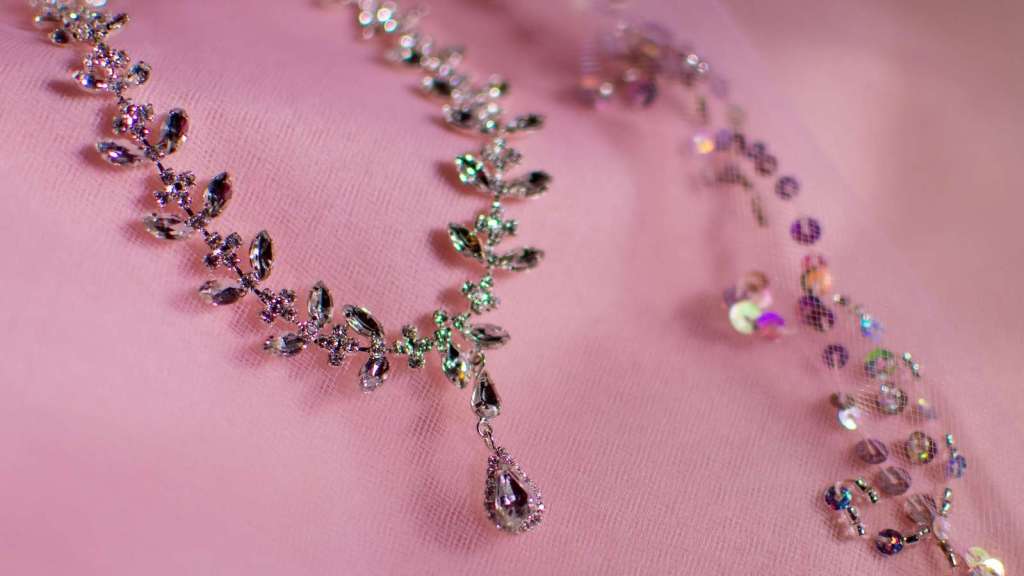Table of Contents
** Minutes
A snapshot of the jewellerymarket in 3 stats
How to start a jewellerybusiness in 10 steps
While many big box stores and major fine jewellerybrands dominate the industry, there is a demand for unique, smaller jewelers. 49% of consumers prefer to purchase their jewelleryfrom small businesses.
The rise of direct-to-consumer (DTC) brands has led to new jewellerybusinesses popping up and winning market share over traditional brick-and-mortar jewellerystores.
While it may seem daunting to start your own jewellerybusiness in a competitive market, if you follow the right steps to building a brand that offers something unique for online shoppers, you’ll be on your way toward great success.
In this post, we’ll discuss everything you need to know on how to start and grow your online jewellerybusiness.
A snapshot of the jewellerymarket in 3 stats
Although highly competitive, there is a great opportunity in building a jewellerybrand. Here are some statistics that illustrate the current state of the online jewellerymarket.
1. Jewelry industry market size
The jewelleryindustry is expected to reach $330 billion by 2026. Currently, China and India are the largest consumers of jewelry, followed by the United States.
Since the jewelleryand accessories market is highly competitive, you’ll want to identify a niche or specialty to stand out in a concentrated market.
You can sell jewelleryfor a target audience and/or that’s designed for a specific purpose (e.g., weddings, prom, themed parties, etc.). When it comes to starting a jewelleryline, there are endless possibilities.

Source: Grand View Research
2. Online jewelers continue to rise
70% of consumers reported they preferred to customise their jewelleryonline, as opposed to in-store. As such, ecommerce currently represents 20% of all jewellerysales.
3. Fine jewellerystill has a presence in traditional retail
Sales for fashion jewelleryare on the rise on ecommerce platforms. Shoppers are likely more willing to buy jewelleryat an affordable price online, rather than pay $1,000 for a piece of fine jewellerythat they haven’t been able to try on in real life.
Additionally, there are higher-stakes inventory risks associated with fine jewelry (such as theft, loss, etc.), making brick-and-mortar retail locations common for many fine jewelers.
How to start a jewellerybusiness in 10 steps
If you’re looking to start selling jewelleryonline, you’ve come to the right place. Below we outline the 10 steps to take before launching a jewellerybusiness.
Step 1. Pick your niche and target market
Before you make your jewellerybusiness idea a reality, make sure there’s a viable target market first, preferably one that isn’t over-saturated. When customers start their search online for jewelry, they often have an idea in mind of what they’re looking for already, so always consider the type of customer you want to attract and make sure you understand what they’re looking for.
Here are some of the most common types of jewellerybrands to help you determine what kind of jewelleryyou want to offer.
Costume jewelry
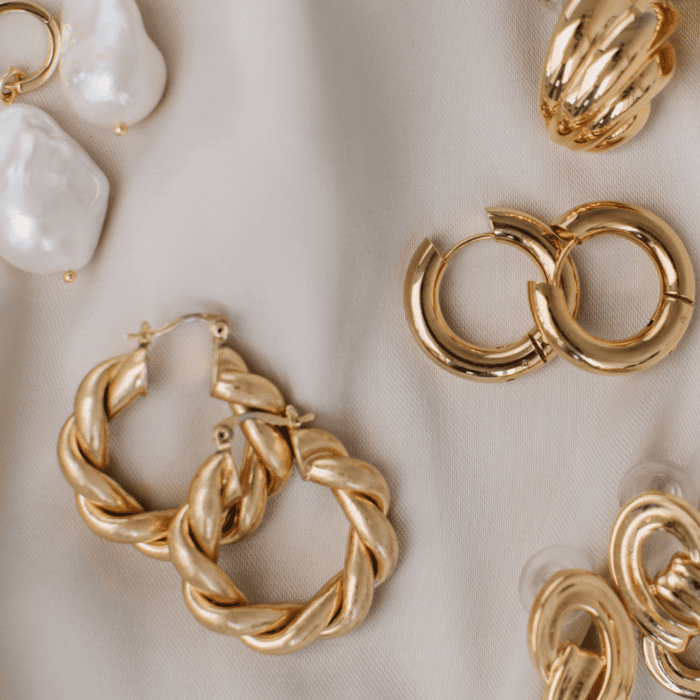
Costume jewelry, also known as fashion jewelry, is meant for everyday use. Unlike fine jewelry, costume jewelleryis more affordable and costs less to produce because it is made from imitation materials like synthetic diamonds, wood, plastic, brass, copper, and other metals.
A single piece of fashion jewelleryshould be priced affordably, anywhere between $5 to $300.
A great example is BaubleBar, one of the biggest online brands for affordable jewelry. They first launched the brand by focusing on affordable jewellerypieces. Once they established a reputation, they expanded their product line by offering higher-end ‘luxury’ pieces.
If you’re thinking of selling costume jewelry, make sure you create a product pricing strategy that’s at an affordable price point, or you’ll miss out on a lot of potential customers.
Fine jewelry
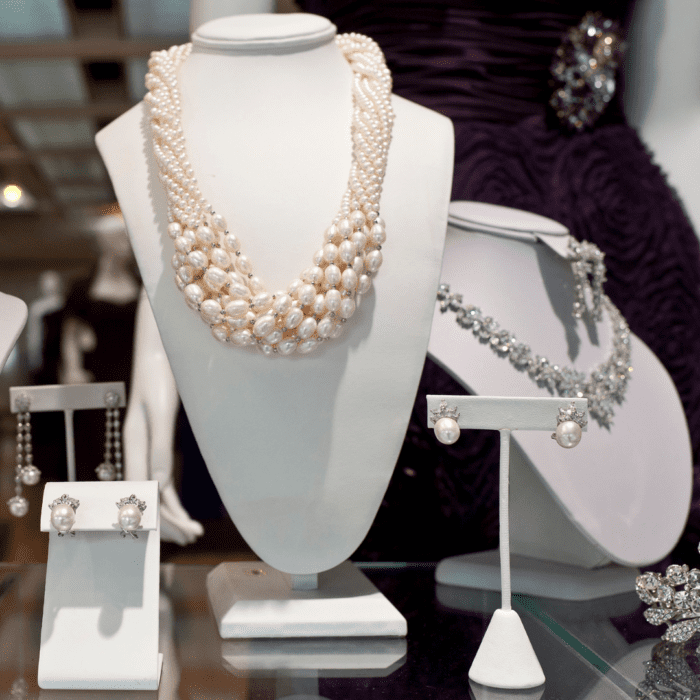
Fine jewelleryis made out of precious metals and gemstones like gold, silver, platinum, diamonds, and rubies. These types of jewelleryproducts are stylish, high quality, and long-lasting. Where fashion jewellerymight be worn daily, these pieces might only be worn occasionally or commemorate a special occasion.
For instance, Brilliant Earth is a fine jewellerybrand that offers engagement rings and wedding bands, in addition to other pieces like necklaces, earrings, and more. Unlike going to a jewellerystore and picking out a ring as is, Brilliant Earth offers an innovative online shopping experience by allowing shoppers to fully customise their ring (e.g., the type of metal, gemstone, shape, etc.) on their ecommerce store.
Fine jewelleryproducts can range from $200 to $3,000 per item (sometimes even more), depending on the type of materials used, size, sourcing, and brand reputation.
Handmade jewelry
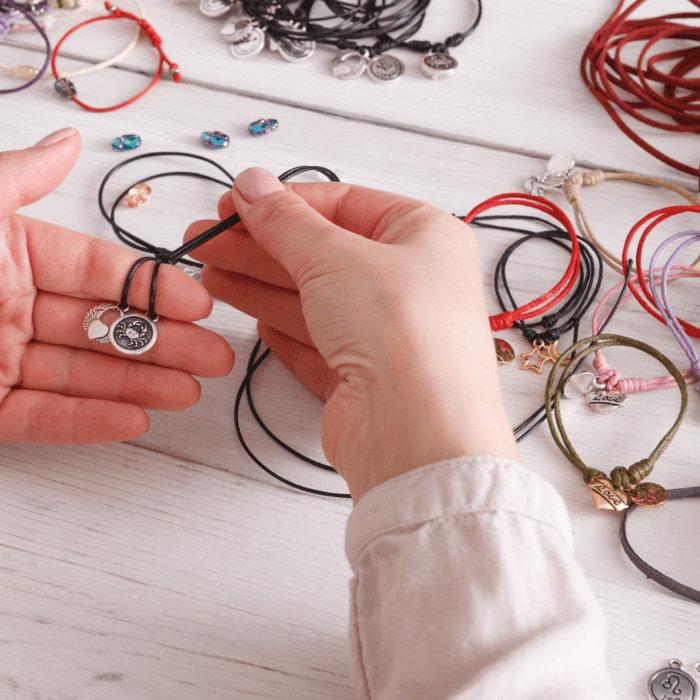
The popularity of online marketplaces like Etsy has shown that customers are eager to purchase handmade jewelleryand other handmade products from artisans. While handmade jewellerycan’t be mass-produced, this is a viable option for business owners who want to make and sell unique jewelleryor custom pieces.
The popularity of online marketplaces like Etsy has shown that customers are eager to purchase handmade jewelleryand other handmade products from artisans. While handmade jewellerycan’t be mass-produced, this is a viable option for business owners who want to make and sell unique jewelleryor custom pieces.
Although marketplaces like Etsy offer a great opportunity for jewelleryartists to sell their custom work and build a following, it can be highly competitive unless you’re willing to play the role of the jewellerydesigner and the marketer to attract Etsy shoppers to your store. It’s also hard to scale if you are making each piece yourself, or if the jewelleryis made-to-order.
As you start up your new business, you may want to consider setting up an online boutique and social media platform to establish an online presence (in addition to using marketplaces like Etsy or eBay).
Step 2. Study the competition
Once you know the type of jewelleryyou want to sell and the audience you want to attract, it’s time to look into the competition. Research their pricing, offers, social media channels and social commerce strategy, reviews, and press coverage, to find out how you can gain a competitive advantage. You’ll want to take notes on what competitors are doing so you can look for ways to further differentiate your product.
For example, let’s say your competitor sells costume jewelleryfor teens, but their negative reviews mention how quickly the items break. With that information, you may decide to promote how your costume jewelleryproduct is long-lasting or offer an extended returns policy.
Another potential competitive advantage to look for is delivery speed since fast, reliable shipping can attract customers and build loyalty. Most online shoppers want their products delivered within two days. If you’re looking to offer 2-day shipping and compete with jewellerybrands that sell on platforms like Amazon or Walmart, you might want to consider partnering with a third-party logistics provider like ShipBob.
Step 3. Develop a business plan
A crucial part of setting your jewellerycompany up for success is creating a thorough business plan and setting business goals. Whether you are self-financed or get financing from a bank, kickstarter, ecommerce venture capital, or a fund, you’ll need a detailed business plan.
With a business plan in place, you can set parameters with a jewellerymanufacturer, calculate the number of products you need to manufacture, and determine your path to profitability. A business plan also makes you look more legitimate to financiers and makes a great first impression in convincing them to invest.
Step 4. Choose a creative name (with an available domain)
Take the time to come up with a creative name that aligns with your brand’s style, mission, and purpose. Your business’s name is important as it needs to be unique enough so customers remember it and not too abstract that people don’t understand what type of product you sell.
You also want to check out the US Trademark Office to make sure your business entity can be trademarked or isn’t currently trademarked. Even if the name is available, you’ll want to check website domain availability, which you can do on website domain and hosting sites like GoDaddy.com.
Step 5. Design a product line
If you’re getting into jewellerybecause it’s your passion, then the product design is the easy part.
If not, there are so many great places to find inspiration, like your favorite jewellerydesigners, the latest trends, insight from doing market research, and more. If you’re making handmade jewelry, learning the trade via jewelleryclasses and tutorials will be important.
Once you have your products designed, you need to figure out how to handle production and procuring supplies in bulk.
Step 6. Choose to outsource manufacturing and suppliers or not
Once you have design concepts for your jewelleryline, you’ll want to research potential manufacturers and decide whether or not you want to produce products locally or overseas. If you’re hand-making your designs, you’ll need to purchase jewelry-making tools and equipment.
It can be beneficial to also ask other jewellerydesigners about trustworthy wholesale distributors or look into getting a reseller license so you can forgo paying local sales taxes when you buy in bulk.
Step 7. Devise a unique brand aesthetic
Designing a brand identity will make your custom packaging and marketing materials stand out — which all plays into creating a remarkable unboxing experience. Find a great custom packaging company to partner with, like noissue or Arka, to help make your packaging stand out.
Don’t forget about your website! Having an online storefront is a great idea so you have a platform where customers can browse your pieces of jewelry. It may be worth hiring a graphic designer to help create a logo and other branding materials for a consistent brand look and feel.
Additionally, you may want to work with a photographer to get professional photographs of your products. Eye-catching product photography can entice customers to make an online purchase.
Step 8. Develop a marketing strategy
Finding potential customers to get your first sale is a challenge for any new jewellerybusiness. Target your marketing towards the demographics most likely to make a purchase. For example, research shows that younger generations (Millenials and Gen Z) are more likely to make jewellerypurchases online, compared to older generations.
As you focus on building a customer base, use the research you compiled, including insight on competition, to develop a multi-channel marketing strategy.
You should incorporate as many channels as possible including:
- Social media – Customers love to research products and reviews before making their decisions. On social media posts, you can highlight what makes your brand different. For example, if you’re focused on sustainability, then post about how your products are good for the environment and add related tags to your posts. Can your jewellerybe worn during exercise? Post images and videos of people working out while wearing your jewelry.
- Email marketing – Contrary to popular belief, email marketing isn’t dead. Growing an email list is one of the best ways to keep your brand on top of mind and improve customer retention. But beware — sending too many emails to customers can exhaust your list and lead to a high rate of unsubscribes, so be sure to follow email marketing best practices. Keep the email clutter-free. Consider sharing a digital business card for contact and other important information, so potential customers always have it handy.
- SMS marketing – SMS ecommerce marketing is a rapidly growing channel for online businesses. With open rates as high as 95%, you can essentially guarantee that everyone on your SMS subscriber list will see your messages and promotions.
- Paid advertising (Google, Facebook, and Instagram) – Many of the largest DTC ecommerce businesses today grew from ad campaigns on channels like Facebook, Instagram, and Google Ads. Ad costs continue to rise, but they can still be a viable channel for jewelers. If you want to run ads, spend time optimising your audience targeting so your ads are served to people who are most likely to buy. And choose your channels wisely — what channels perform best for other brands might not work best for you.
- Search engine optimisation (SEO) – Many online businesses rely on social media ads to make sales, ad costs are continuing to rise. With a good SEO strategy and blog content plan, your product listings, blog posts, videos, guides, and other types of owned content can show up at the top of search results and get more traffic without increasing your ad spend. When looking for the right keywords to attract organic traffic, use SEO tools like Google AdWords or Moz to find keywords that have a high search volume with low competition.
- Affiliate/influencer marketing – It is crucial to borrow affiliates’ or influencers’ reach to attract traffic to your new business. Simply put, create an affiliate program to incentivize people to join and reward those who bring you successful sales with a commission. By setting up an affiliate program, you can optimise your return on investment and only pay for the leads that convert to sales.
Step 9. Build your own online store with an ecommerce platform
Building an ecommerce website is easier than ever due to the numerous ecommerce platforms, apps, and integrations available. Ecommerce platforms are designed to make setting up an online store as seamless as possible. Some of the most popular ecommerce platforms include Magento, Shopify, BigCommerce, WooCommerce, Squarespace, and Wix.
An alternative to building your own website is to create a store on Etsy, but it’s more suited for handmade jewelleryand made-to-order items. And since it’s a marketplace, it’s harder to get exposure and traffic to your Etsy store. Plus, Etsy gets the ‘credit’ for the sale as people won’t necessarily remember your brand, just that they bought on Etsy.
Step 10. Find a fulfilment solution
As you start out, you’ll probably need to store inventory in your home and self-fulfil orders. This might work at first, but as your grow your business, you’ll eventually need to rethink your fulfilment strategy. Once you reach a point when it’s hard to keep up with packing and shipping orders on time, you’ll want to consider outsourcing fulfilment to a fulfilment partner, so you can focus more of your time and energy on other parts of your business.
Fulfil orders without lifting a finger with ShipBob
There are many reasons to work with an order fulfilment partner like ShipBob for your jewellerybusiness. With industry-leading expertise in fulfilment and logistics, we’ve helped some of the fastest-growing DTC jewellerybrands scale their growth by taking care of ecommerce shipping for them.
Scalability
As your jewellerybusiness grows, hiring the right people with logistics and warehousing expertise is a time-consuming process. Finding warehouse space is expensive and can take a while for you to get up and running. With ShipBob, you get access to our entire network of over 50 fulfilment centres, our technology, and our operations infrastructure.
Amazon made two-day shipping the norm and many small businesses don’t have the resources to support two-day shipping, which can lead to a high cart abandonment rate. With ShipBob, jewellerybrands can offer affordable two-day shipping to help compete with retail giants.
“We looked into opening our own ecommerce warehouses and hiring employees, but couldn’t come close with what 3PLs charge for picking, packing, and shipping. We’d also be worried about scheduling fulfilment shifts, ordering boxes and shipping labels, and dealing with the extra headaches of running logistics. Our order volume has seen ebbs and flows, and ShipBob has fulfilled over 10,000 shipments per month for us, with Black Friday/Cyber Monday and our summer season being our most in demand times of the year.”
Gerard Ecker, Founder & CEO of Ocean & Co.
Inventory and order management technology

ShipBob’s platform comes with built-in order and inventory management software. Get accurate inventory counts, reorder point notifications, easily create bundles, and more.
“We roll out new products and designs on our website 1-3 times a month and send new inventory to ShipBob each week. It’s really easy to create new SKUs and restock existing ones using ShipBob’s technology, which is especially important with high inventory turnover.”
Carl Protsch, Co-Founder of FLEO
Data and analytics
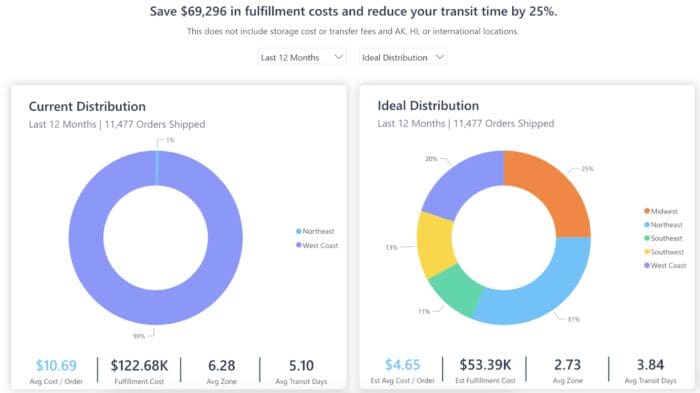
ShipBob’s free analytics tool gives you the data needed to run a successful jewellerybusiness online by offering full visibility into the entire fulfilment process. Get real-time data on fulfilment performance, transit times, shipping costs, inventory forecasting, inventory distribution (as seen above) and much more.
“At my previous 3PL, everything was done on spreadsheets and it was very difficult to get the fulfilment data I needed. Now, we’re working with a tech-enabled 3PL that seamlessly provides data to help us make business decisions. ShipBob’s analytics tool is a game-changer and it’s helped me grow my business tremendously.”
Courtney Lee, founder ofPrymal
Conclusion
Starting a jewellerybusiness is an exciting endeavor, and it’s never been easier to start a successful business online, but that doesn’t mean it comes with challenges. As you grow your jewellerybusiness, you might find it hard to keep up with fulfilling a high volume of orders. If you’ve reached this point of growth, it might be time to outsource ecommerce fulfilment.
Get started with ShipBob
To learn how ShipBob can help make the process of working with a fulfilment partner easy, connect with our team to get a custom quote.
Online jewellerybusiness FAQs
Here are answers to the most commonly asked questions about online jewellerybusinesses.
What are the initial costs involved in starting a jewellerybusiness?
There are several upfront costs you should be aware of if you choose to start a jewellerybusiness. Training and education, licenses and permits required to start an LLC, equipment and tools, inventory, website and online store, marketing and branding, packaging and shipping (or fulfilment provider, if you choose to outsource order fulfilment) are some of the most basic expenses needed to start a business.
Selling in a brick-and-mortar store requires additional expenses. You can expect to spend anywhere from a few thousand to a few hundred thousand, depending on your business goals.
How do I determine the pricing for my jewelleryproducts?
You’ll want to consider several factors when determining the price of your jewelry. First, you should calculate the costs associated with producing each piece (including raw materials and labour). Next, you’ll want to determine the amount of profit you want to make from each piece. With those factors in mind, you can determine your initial price point.
However, it’s important to keep pricing in mind since it is prone to fluctuating. You may want to research competitors, listen to customer feedback, and factor in economic circumstances, and adjust prices when necessary.
What are some of the best platforms to sell jewelleryonline?
There are many ecommerce platforms that are good for jewellerybusinesses. Shopify, WordPress, BigCommerce, Squarespace, and Square are among the most popular platforms for jewellerybrands selling online.
How do I handle shipping and fulfilment for my jewelleryproducts?
If you are just starting your jewellerybusiness, you may opt to fulfil your order from your home or workshop. This means you pick, pack, and ship the orders on your own. Self-fulfilment might initially be a good solution, especially if you handmake your jewelry.
However, as you scale, you may need to lean on a fulfilment partner to fulfil and ship orders on your behalf. Outsourcing fulfilment to a partner like ShipBob allows you to reclaim time previously spent on shipping and put it back into your jewellerybusiness.
What are the legal considerations I need to be aware of when starting a jewellerybusiness?
It’s important to set up your business properly to ensure you are legally able to operate your jewellerybusiness. You should set up a legal structure (such as an LLC), obtain the proper permits and licenses (refer to your local governing body for details), register any trademarks or patents (if needed), formalize agreements with vendors and manufacturers, and abide by employment laws.
